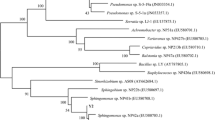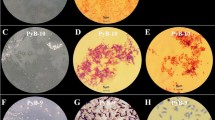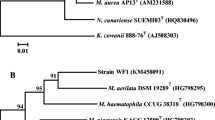Abstract
A phenanthrene-degrading strain PHE3, identified as the genus of Sphingobium, was isolated using a two-liquid-phase partitioning bioreactor. More than 96 % of the initial amount (up to 100 mg l−1 silicone oil) of phenanthrene was removed within 77 h by PHE3. Degradation of phenanthrene by PHE3 at pH 7 was also observed in the presence of Cu (II), Zn (II) and Cd (II) ions. Cu (II) showed the highest toxicity to PHE3, followed by Cd (II) and Zn (II). Tolerance to Cu (II) by PHE3 was up to 20 mg l−1 in terms of total aqueous concentration, and up to 40 mg l−1 for both Zn and Cd. Interestingly, 20 mg l−1 of Zn (II) stimulated phenanthrene degradation after 20 h incubation. Its high tolerance to toxic metals and phenanthrene degradation ability of PHE3 highlights its significance in the study of microbial remediation in soils co-polluted by PAHs and metals.




Similar content being viewed by others
References
Atagana H (2006) Biodegradation of polyacyclic aromatic hydrocarbons in contaminated soil by biostimulation and bioaugmentation in the presence of copper(II) ions. World J Microbiol Biotechnol 22(11):1145–1153
Atagana HI (2009) Biodegradation of PAHs by fungi in contaminated-soil containing cadmium and nickel ions. Afr J Biotechnol 8(21):5780–5789
Bouchez M, Blanchet D, Vandecasteele JP (1997) An interfacial uptake mechanism for the degradation of pyrene by a Rhodococcus strain. Microbiology 143(4):1087–1093
Cunliffe M, Kertesz MA (2006) Effect of Sphingobium yanoikuyae B1 inoculation on bacterial community dynamics and polycyclic aromatic hydrocarbon degradation in aged and freshly PAH-contaminated soils. Environ Pollut 144(1):228–237
Daugulis AJ, Janikowski TB (2002) Scale-up performance of a partitioning bioreactor for the degradation of polyaromatic hydrocarbons by Sphingomonas aromaticivorans. Biotechnol Lett 24:591–594
Deveryshetty J, Phale PS (2009) Biodegradation of phenanthrene by Pseudomonas sp. strain PPD: purification and characterization of 1-hydroxy-2-naphthoic acid dioxygenase. Microbiology 155(9):3083–3091
Déziel E, Comeau Y, Villemur R (1999) Two-liquid-phase bioreactors for enhanced degradation of hydrophobic/toxic compounds. Biodegradation 10(3):219–233
Guieysse B, Cirne MDDTG, Mattiasson B (2001) Microbial degradation of phenanthrene and pyrene in a two-liquid phase-partitioning bioreactor. Appl Microbiol Biotechnol 56:796–802
Holt JG, Krieg NR, Sneath PH, Staley JT, William ST (eds) (1994) Bergey’s manual of determinative bacteriology, 9th edn. William and Wilkins, Baltimore
Houba VJG, Lexmond ThM, Novozamsky I, van der Lee JJ (1996) State of the art and future developments in soil analysis for bioavailability assessment. Sci Total Environ 178(1–3):21–28
Insam H, Hutchinson TC, Reber HH (1996) Effects of heavy metal stress on the metabolic quotient of the soil microflora. Soil Biol Biochem 28(4–5):691–694
Janikowski TB, Velicogna D, Punt M, Daugulis AJ (2002) Use of a two-phase partitioning bioreactor for degrading polycyclic aromatic hydrocarbons by a Sphingomonas sp. Appl Microbiol Biotechnol 59(2–3):368–376
MacLeod CT, Daugulis AJ (2005) Interfacial effects in a two-phase partitioning bioreactor: degradation of polycyclicaromatichydrocarbons (PAHs) by a hydrophobic Mycobacterium. Process Biochem 40(5):1799–1805
Malakul P, Srinivasan KR, Wang HY (1998) Metal toxicity reduction in naphthalene biodegradation by use of metal-chelating adsorbents. Appl Environ Microbiol 64(11):4610–4613
Marcoux J, Déziel E, Villemur R, Lépine F, Bisaillon J-G, Beaudet R (2000) Optimization of high-molecular-weight polycyclic aromatic hydrocarbons degradation in a two-liquid-phase bioreactor. J Appl Microbiol 88:655–662
Moberly JG, Staven A, Sani RK, Peyton BM (2010) Influence of pH and inorganic phosphate on toxicity of zinc to Arthrobacter sp. isolated from heavy-metal-contaminated sediments. Environ Sci Technol 44(19):7302–7308
Muñoz R, Guieysse B, Mattiasson B (2003) Phenanthrene biodegradation by an algal-bacterial consortium in two-phase partitioning bioreactors. Appl Microbiol Biotechnol 61(3):261–267
Nadalig T, Raymond N, Ni’matuzahroh, Gilewicz M, Budzini H, Bertrand J (2002) Degradation of phenanthrene, methylphenanthrenes and dibenzothiophene by a Sphingomonas strain 2mpII. Appl Microbiol Biotechnol 59(1):79–85
Panikov NS, Sizova MV (1996) A kinetic method for estimating the biomass of microbial functional groups in soil. J Microbiol Meth 24(3):219–230
Prakash O, Lal R (2006) Description of Sphingobium fuliginis sp. nov., a phenanthrene-degrading bacterium from a fly ash dumping site, and reclassification of Sphingomonas cloacae as Sphingobium cloacae comb. nov. Int J Syst Evol Microbiol 56(9):2147–2152
Romero MC, Cazau MC, Giorgieri S, Arambarri AM (1998) Phenanthrene degradation by microorganisms isolated from a contaminated stream. Environ Pollut 101(3):355–359
Song YF, Wilke BM, Song XY, Gong P, Zhou QX, Yang GF (2006) Polycyclic aromatic hydrocarbons (PAHs), polychlorinated biphenyls (PCBs) and heavy metals (HMs) as well as their genotoxicity in soil after long-term wastewater irrigation. Chemosphere 65(10):1859–1868
Sukul P, Spiteller M (2001) Influence of biotic and abiotic factors on dissipating metalaxyl in soil. Chemosphere 45(6–7):941–947
Supaka N, Pinphanichakarn P, Pattaragulwanit K, Thaniyavarn S, Omori T, Juntongjin K (2001) Isolation and characterization of a phenanthrene-degrading Sphingomonas sp. strain P2 and its ability to degrade fluoranthene and pyrene via cometabolism. Sci Asia 27:21–28
Tao XQ, Lu GN, Dang Z, Yi XY, Yang C (2007) Isolation of phenanthrene-degrading bacteria and characterization of phenanthrene metabolites. World J Microbiol Biotechnol 23(5):647–654
Villemur R, Déziel E, Benachenhou A, Marcoux J, Gauthier E, Lépine F, Beaudet R, Comeau Y (2000) Two-liquid-phase slurry bioreactors to enhance the degradation of high-molecular-weight polycyclic aromatic hydrocarbons in soil. Biotechnol Prog 16(6):966–972
Wang CY, Wang F, Wang T, Bian YR, Yang XL, Jiang X (2010) PAHs biodegradation potential of indigenous consortia from agricultural soil and contaminated soil in two-liquid-phase bioreactor (TPPB). J Hazard Mater 176(1–3):41–47
Xiao J, Guo L, Wang S, Lu Y (2010) Comparative impact of cadmium on two phenanthrene-degrading bacteria isolated from cadmium and phenanthrene co-contaminated soil in China. J Hazard Mater 174(1–3):818–823
Yang Y, Tao S, Zhang N, Zhang DY, Li XQ (2010) The effect of soil organic matter on fate of polycyclic aromatic hydrocarbons in soil: a microcosm study. Environ Pollut 158(5):1768–1774
Zhang MK, Liu ZY, Wang H (2010) Use of single extraction methods to predict bioavailability of heavy metals in polluted soils to rice. Commun Soil Sci Plan 41(7):820–831
Acknowledgments
This research was supported by the National Natural Science Foundation of China (Nos. 41101297, 41030531 and 21277148). The authors gratefully acknowledge Mr. Zhiming Shi (Nanjing Agricultural University) for his assistance in strain isolation.
Author information
Authors and Affiliations
Corresponding author
Additional information
Congying Wang and Fang Wang contributed equally to this work.
Rights and permissions
About this article
Cite this article
Wang, C., Wang, F., Hong, Q. et al. Isolation and characterization of a toxic metal-tolerant Phenanthrene-degrader Sphingobium sp. in a two-liquid-phase partitioning bioreactor (TPPB). Environ Earth Sci 70, 1765–1773 (2013). https://doi.org/10.1007/s12665-013-2264-8
Received:
Accepted:
Published:
Issue Date:
DOI: https://doi.org/10.1007/s12665-013-2264-8




